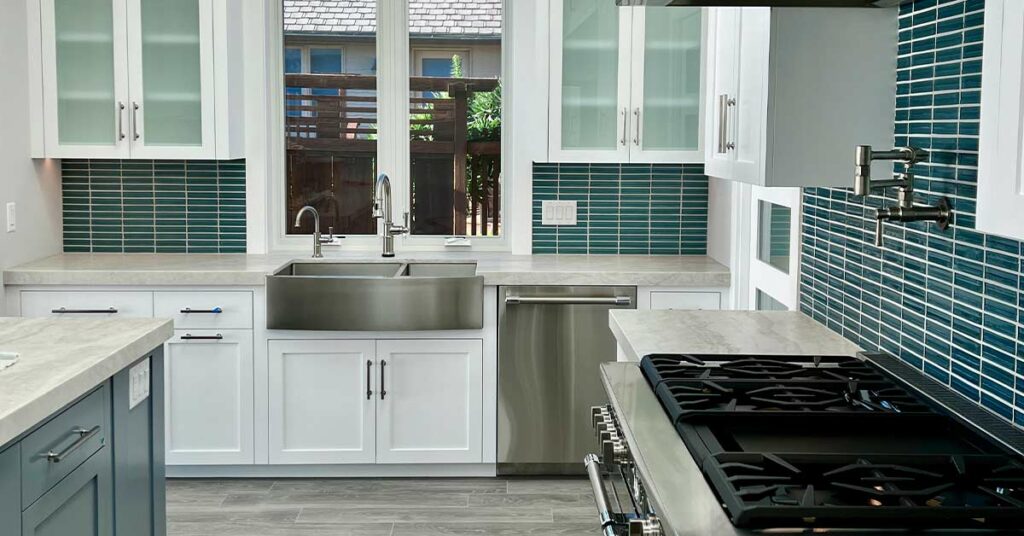
There are so many types and varieties of tile that it would be impractical to list them all here. However, we can give you a better idea of what types of tile you may want think about for your intended use. Is marble a bad idea for a bathroom shower? Are terra cotta tiles appropriate for outdoor areas? And where is the best place for glossy ceramic tile? In this article, we will consider the major types of tile and the most appropriate locations in your home for them.
Tile manufacturers have done a great job of making sure there’s a tile for everyone, from cost-effective materials for budget-conscious homeowners to indulgent selections for luxury-oriented buyers. Tile selection can seem overwhelming since tiles come in a wide variety of colors, shapes, and sizes, and are highly customizable.
Consider the important strengths and vulnerabilities of different types of man-made and natural stone tile. Understanding these qualities can help you determine how suitable the material is for your new construction or home renovation project.
Ceramic Tile Family
Ceramic is a very broad term used to describe a lot of different floor and surface tiles in the “ceramic tile family.” American National Standard Specifications for Ceramic Tile (ANSI 137.1) lists the five major types of ceramic tiles: porcelain, pressed floor, mosaic, quarry, and glazed wall tiles.
Sometimes people get confused about ceramic and porcelain, because all porcelain tiles are ceramic, but not all ceramic tiles are porcelain. According to the TCNA Handbook for Ceramic, Glass, and Stone Tile Installation, “Porcelain tiles are ceramic tiles for floor and wall applications with a water absorption rate of 0.5% or less…”
Tile Applications
Depending on how a tile is produced and what characteristics and properties it has, it may be suitable for the following applications:
- High-traffic areas
- Entrances
- Hallways
- Living rooms
- Kitchens
- Bathrooms
- Kids play areas
- Mudrooms
- Laundry rooms
- Staircases
- Exterior living spaces
- Pool and patio areas
NOTE: Some tile options are more suitable than others for specific applications. Check out the details manufacturers share about their products on their websites before you make your tile selection.
Porcelain Tile
Porcelain tile boasts greater strength than ceramic tile while providing all of the aesthetic and functional options of ceramic tile. This impervious tile has such a minimal degree of porosity that it is called non-porous. Since any pores, or tiny holes, are so few and far between, water and staining agents generally will not cause damage or discoloration to porcelain tile.
If you’re looking for low-maintenance, easy-to-clean material, porcelain is an excellent choice.
Porcelain is heavy, so projects can sometimes be restricted from upper floors, depending on the weight limits of your building.
Ceramic Tile
Ceramic shares certain qualities with porcelain. Ceramic tiles are fairly resistant to physical damage, water, and heat, making them suitable for high traffic areas, kitchens, bathrooms, and exterior applications. However, ceramic is not as durable as porcelain, and signs of wear will show sooner with this lower-quality material.
Compared to porcelain, ceramic tiles are lighter weight and easier for installers to cut and handle. Consequently, it is more affordable to have ceramic tiles installed. Homeowners on a budget, armed with the knowledge that ceramic tiles will have to be replaced sooner than porcelain, will sometimes choose ceramic anyhow because of the immediate cost savings.
Thin-Brick Veneer
Thin-brick veneer is considered part of the ceramic tile family. Although this rustic and inviting material is best known for vertical applications like walls and backsplashes, it can be used elsewhere. Some types of sealed thin-brick veneer tiles are manufactured to withstand high-traffic or wet areas, but this material should not be used in steam showers or shower pans.
If structural weight is a consideration, thin-brick veneer would be more appropriate than whole stone or brick installations.
To learn more about how well your potential ceramic tile selection might hold up in the area you want to have it installed, read this article by Rubi Tools: What’s a Ceramic Tile PEI Rating?
Encaustic Tile, Pressed Cement Tile, and Concrete Tile
According to the Tile Heritage Foundation, encaustic tiles are “inlaid tiles, where one or more different colored clays are inlaid in a clay tile that is then fired and normally destined for a floor installation.” Encaustic tiles are ideal for high-traffic interiors or covered exterior living spaces and entryways like front and back porches. As traffic and use wear away at the surface, the design remains consistent since the design goes all the way through the tile.
Pressed cement tiles are porous, therefore susceptible to staining if unsealed or if too much time passes between periodic professional cleaning and sealing. Heavy foot traffic can also alter the appearance of the tile, so the use of floor mats is advised.
Pressed cement tiles are best suited for living rooms and dens, home offices, and bedrooms. Avoid sun rooms or rooms with heavy direct sunlight, because of the potential for color fading, bathrooms and kitchens where the tile can stain or damaged by acidic substances, and high-traffic areas like entryways.
The above-mentioned article also states, “Although sometimes mistakenly called encaustic tile, which refers to kiln-fired clay tile or commonly used ceramic tiles, cement tiles are not fired and have no glaze layer on the face of the tile.”
Concrete tile is timeless, versatile, and adaptable to almost any room. It’s durable and easily cleanable with mild soap. Just be sure to completely remove soap to prevent soap scum buildup. For maintenance, concrete tile must be sealed regularly, due to its porous nature. This also means that spills must be cleaned immediately to avoid stains.
Concrete tile can feel cold and hard underfoot by itself, so consider comfort when making your design choices. It’s important to note that concrete is susceptible to harsh weather conditions, so check the manufacturer product information before having this material installed on balconies, porches, and patios.
To learn more about encaustic tile, pressed-cement tile, and concrete tile, read the Tile Letter article, Will the true encaustic tile please rise?
Glass Tiles
Glass tiles have almost no moisture absorption, so they are easy to clean and do not easily stain. This material is an excellent option for adding a luminous and modern touch to kitchens, bathrooms, and other areas. Consider using glass tile for backsplashes, tub surrounds, shower walls, and other vertical applications. Glass tiles can be incorporated beautifully in mosaic installations. For a unique twist, ask your installer to add backlighting behind translucent glass tiles.
Installers use specialized tools to cut glass tiles, which can chip easily during the installation process. The challenges involved in glass tile installation surpass those of porcelain and ceramic, elevating installation costs.
Mosaic glass tile can be used on floors, but since it is susceptible to scratching from abrasives underfoot, it is only suitable for low-traffic areas.
How well will the tile you select stand up to wear?
In the tile and stone industry, experts perform what is called destructive tests. These tests work just as one might imagine. Experts use machines to damage and destroy tile. They see how much abuse a tile can take before signs of damage appear and use this information to determine the service rating of tile. That way, people know what to expect from the tile they select for their floors and surfaces.
Regarding surface wear resistance, according to the TCNA Handbook for Ceramic, Glass, and Stone Tile Installation, “manufacturers must clearly and definitively state the surface wear classification of a tile.” You’ll need to read the fine print from the manufacturer to make an informed decision about your tile selection.
How well will the tile you select stand up to temperature changes?
Only impervious (less than 0.5% moisture absorption) tiles should be installed in exterior areas exposed to freeze-thaw cycling. Although freezing temperatures are unusual for Central Coast California, they are certainly possible.
Special Considerations for Tile Selection
Home gyms are not a good place to install tile. Weights dropped during workouts would likely damage tile flooring.
Tile can feel cold and hard underfoot. These problems can be remedied by installing radiant heating and softening the floor space with throw rugs and area rugs, and for spaces where people tend to stand in one place for a long time, like the kitchen sink or stove, anti-fatigue mats.
For more solid advice on tile selection for your project we recommend homeowners consult with Design Consultants at Tileco Tile and Stone Showrooms. You’re welcome to reach out to us, as well.
by Alice Dean
Copher Tile & Stone proudly stays up to date on tile installation with ongoing education with Mapei Technical Institute, Ardex Academy, the National Tile Contractors Association, Laticrete, and Schluter. Copher is a Certified Tile Installer (#1644).

